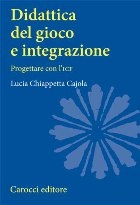- Curriculum [pdf] (3,00MB)
- Slideshow [ppt] (5,70MB)
You are here: Home | Synergia Magazine
Synergia Magazine
Didattica del gioco e integrazione. Progettare con l’ICF
Book review

[Mutamento Sociale n.35 - May 2012]
As well known to educators and teachers, children and adolescents with disabilities or in distress and discomfort manifest original needs that require specific and targeted interventions. The International Classification of Functioning, Disability and Health (ICF), with its three levels of observation (of the body, the person, environment), is certainly one of the most interesting and appropriate methodological tools for this purpose.
In particular, the detection of playful behavior in different phenomenal manifestations may have a strong value orientation of the actions of teachers. It is no coincidence that the ICF version for children and adolescents (ICF-CY), covering a variety of categories related to the game, is to emphasize the importance of contributing to the state of well being, both in recognizing their impact on the "operation" and the strategic value in the process of development and learning. These categories, further declined in relation to the training objectives and needs of children-pupils, give rise to specific lists of descriptors and grids of observation, of which the volume provides ample examples. Proposals for animated games are also presented, with educational goals and educational-methodological adaptations and examples of descriptors for the observation and evaluation which are essential for the design of the intervention, from nursery to secondary school.
Lucia Chiappetta Cajola, Didattica del gioco e integrazione. Progettare con l’ICF, Carocci Editore, Roma, 2012
In particular, the detection of playful behavior in different phenomenal manifestations may have a strong value orientation of the actions of teachers. It is no coincidence that the ICF version for children and adolescents (ICF-CY), covering a variety of categories related to the game, is to emphasize the importance of contributing to the state of well being, both in recognizing their impact on the "operation" and the strategic value in the process of development and learning. These categories, further declined in relation to the training objectives and needs of children-pupils, give rise to specific lists of descriptors and grids of observation, of which the volume provides ample examples. Proposals for animated games are also presented, with educational goals and educational-methodological adaptations and examples of descriptors for the observation and evaluation which are essential for the design of the intervention, from nursery to secondary school.
Lucia Chiappetta Cajola, Didattica del gioco e integrazione. Progettare con l’ICF, Carocci Editore, Roma, 2012
Company profile
Download the company profile and the slideshow of Synergia activities and projects.
Fields of operation
- Qualità in RSA
- Planning of services
- Information Systems and Social Observatories
- Quality and services organisation
- Elderly conditions
- Family and the new generations
- Mental health and addictive behaviours
- Non self-sufficiency and Social and health integration
- Migration and intercultural studies
- Labour and employability
- Training activities
- Monitoring social change
Copyright © 2009-2016 Synergia srl - Tutti i diritti riservati
Via Settala, 8 - 20124 Milano
Tel. 02.72093033 - Fax 02.72099743
P.IVA 09570410150
chantive-solutions
Magazine | Customers | Partners | News | Legal info


